Article and photos by Joe Sapia
Note: The yard references are to my house in the section of Monroe between Helmetta and Jamesburg in South Middlesex County. My yard is in a Pine Barrens outlier on the Inner Coastal Plain, the soil is loamy, and my neighborhood is on the boundary of Gardening Zones 6b (cooler) and 7a (warmer). Afield references are to the Pine Barrens around Helmetta, unless otherwise noted. Notes and photographs are for the period covered, unless otherwise noted.
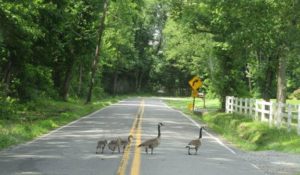
Mama and Papa Canada geese, “Branta canadensis,” and their young cross a road in the Dayton section of South Brunswick, Middlesex County, and stop my Jeep in its tracks. Silly geese! (On a serious note, humans could learn from the dedicated parenting of Canada geese.)
GOOD TO BE BACK HOME: Sorry for missing last week’s “Garden and Afield,” but I was down in New Orleans or traveling to and from. I was attending receptions for a medical residency graduation (of Dr. Anthony M. Sciascia II, the son of my college buddy) and wedding (of Anthony and Nancy). I had a wonderful time with the Sciascia clan who has treated me as family since our Marquette University days that began more than 40 years ago. But I always enjoy getting back home….
SOME N’AWLINS FLAVOR IN THE JERSEY MIDLANDS: New Orleans is known for its coffee made from the roots of chicory, “Cichorium intybus.” Well, guess what has began blooming in the Jersey Midlands? Chicory, the blue flower along roadsides and other disturbed areas. It is a foreign species naturalized here. That is, a weed. But a weed with a nice-looking flower.
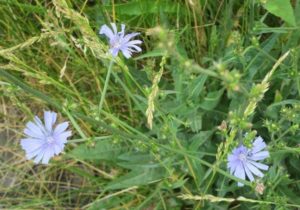
Chicory growing on a Monroe roadside.
IN THE GARDEN: While I was gone, my garden did not get its daily watering, even more critical because we had some very hot temperatures, near 100! But I began harvesting lettuce in earnest.
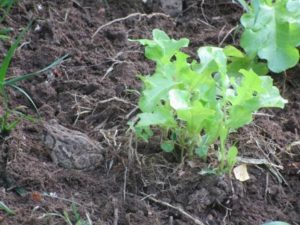
Lake Valley Seeds’s “Salad Bowl Green Heirloom Lettuce” grows in my garden. Next to the lettuce is nature’s pesticide, a toad — probably an American toad, “Anaxyrus americanus.” (Thanks to Sam Skinner, a Monmouth County Park System naturalist who set me in the right direction on the tentative identification of this toad.)
MY ORGANIC GARDEN: I just mentioned the wild toad as a natural pesticide. But, nowadays, people seem to be touchy over the term “organic,” arguing its meaning or arguing that “organic” does not mean purely natural. As I was taught in journalism, say exactly what you mean, rather than using labels. So, here is how I food garden – I add nothing to the mix except water.
MANALAPAN BROOK: The Brook flows about 400 feet from my front yard, but, thankfully, I am about 150 feet from its floodplain – so, close enough to enjoy the waterway, but far enough away not to be affected by flooding. This time of year, the Brook has a summer feel, with lush vegetation growing in the floodplain and, on this day, bright sunlight creeping through the trees. My section of the Brook is between “Jamesburg Lake” (Lake Manalapan) and “Spotswood Lake” (DeVoe Lake). Its watershed drains 40.7 square miles, according to the United States Geological Survey, in Middlesex and Monmouth Counties.
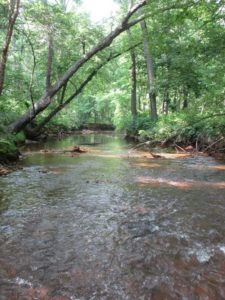
Manalapan Brook, looking downstream toward Helmetta
LIGHTNING BUGS: I saw the first lightning bug, a member of the “Lampyridae” insect family, of the season June 4. On June 17, as I was putting together this “Garden and Afield,” I watched fireflies in my backyard. There seemed to be more than normal, maybe a half-dozen to a dozen, but not the numbers I remember when I was a kid. They flash to signal mates.
ELSEWHERE IN THE YARD: Also in the yard over the last two weeks were rabbit, genus “Lepus”; the state bird, the Eastern goldfinch, “Spinus tristis,”; and my friend, the catbird, “Dumetella carolinensis.” The rabbits allow me to get within a few feet of them, probably because I go about my normal business, not TRYING to get close. The male goldfinch is brightly colored, a beautiful bird – “wild canaries” in the yard. I love catbirds. When I work in the yard or hike the Pine Barrens around Helmetta, catbirds perch nearby and keep me company.
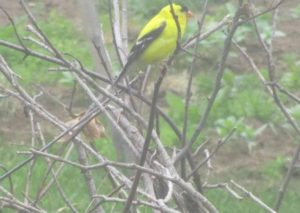
An Eastern goldfinch. Brightly colored, so it is a male.
WHITE ORCHID: Faye Bray, a friend from the Outdoor Club of South Jersey, reported a rare white variety of the pink lady-slipper orchid, “Cypripedium acaule,” in the Whitesbog, Burlington County, area of the Pine Barrens. “It’s freaking remarkable,” Faye said. (Unfortunately, we could not get a photograph for “Garden and Afield.”)
TURTLES: Turtles have been laying eggs, meaning females have been moving around. On my trip to and from New Orleans, I saw a half-dozen or so dead along the Interstate highways, apparently struck by vehicles. Up here in the Midlands, I have heard of various encounters with turtles. One, a person moved a box turtle, “Terrapene carolina,” to water. Wait, a box turtle is a land animal. Two, another person moved a snapping turtle, “Chelydra serpentina,” to a pond, possibly interrupting its egg-laying. So, my advice is, unless there is a compelling reason, leave wildlife alone. Generally, it knows what it is doing, it does not need humans to mess up its life.
TICKS: Ticks are bad this year. Essentially, they cling to vegetation and wait for a mammal to brush by them, then they attach. We have three ticks locally: deer tick, “Ixodes scapularis”; lone star tick, “Amblyomma americanum,” The female is easily distnguishable by the light-colored dot on her back; wood tick, also known as the dog tick, “Dermacentor variabilis.”
Get a tick ID pocket card. It will show the size and colors of not only these ticks, but in different stages of development. See http://www.tickencounter.org/tick_identification/guide.
There is no need to panic. Tick-borne diseases are relatively rare — I mean, if everyone in range of a tick, or even bitten by a tick, were to get sick, there would be a very sick population. However, be vigilant. In the yard, keep grass trimmed. If in the woods, take precautions by dressing properly. (If I am wearing long pants, for example, I tuck them in my socks.) And check for ticks on one’s body. When coming in from the woods or other places ticks are likely, wash the clothes and bathe as soon as possible.
If a tick is crawling on oneself, simply flick it off — It may take a few tries. If one is attached, take tweezers and grab it behind the head and pull it out. Then flush it down the toilet, throw it in a fire, or, if needed for observation, put it with an alcohol-doused cotton swab in a closed container.
If bitten, observe the bite for abnormalities, such as the Lyme Disease bull’s eye, seek medical help if concerned. The big tick disease locally is Lyme. However, New Jersey is now watching for Powassan virus.
My yard is wildlife-friendly and I take no special precautions in the yard, other than observing my clothes and body. I am always in the woods and fields, I found one tick on my body this season, but 10x or 20x that on my clothes — the point being, notice them before they get on one’s body.
Regarding the yard, keep the grass cut. I have tall-grass wildlife patches in my yard and have not found a tick on me yet while doing yardwork, etc. I would be more concerned with cats and dogs bringing them inside.
If you look them up online, use the scientific name, so as not to confuse species and colloquial names.
LETHAL ANIMALS: I would say on a daily basis, the three most lethal animals in the Pine Barens around Helmetta are the tick, mosquito, and pet dog. The former two could do a number for life, while the latter one could be hurtful for the moment.
In the Piedmont region of the Jersey Midlands, I would add copperhead snake, “Agkistrodon contortrix.” In the main Pine Barrens, the rattlesnake, “Croatus horridus.” But the chances of getting bit by either is rare.
Throughout the Midlands, a wandering black bear, “Ursus americanus,” could be a threat – but unlikely. If you see one, stay clear and that should be enough.
YOU SAY “MUSKMELON,” I SAY “MUSHMELON”: My friend Virginia Lamb, who I have turned to for advice (environmental, gardening, and general) over the years, said in reference to my using “mushmelon,” “It’s ‘muskmelon, not ‘mushmelon.’” She is correct, in a more formal sense. But I am correct, too, in a more informal way. So, I responded in an e-mail, “Local colloquialism = mushmelon. I use that only in my blog. Normally, when I talk, I say cantaloupe. (Kind of like the colloquialism “garden snake” for “garter snake.)” Yes, we are all talking cantaloupe.
SCIENTIFIC NAMES: My use of scientific names also has prompted some discussion. Sunil Nair, who has followed my Internet nature posts, said, “Love the fact that you write the genus names, too.” But Virginia Lamb noted, “Just a note on reader preference: I feel the Latin names interrupt the folksy flow of the prose and would prefer they be noted at the end. But that may just be me.” I am considering Virginia’s point. As for using scientific names, I do it so there is no question what is being discussed. “Swamp pink” could be the “Arethusa bulbosa” orchid or it could be the “Helonias bullata” lily. But a scientific name is a scientific name is a scientific name.
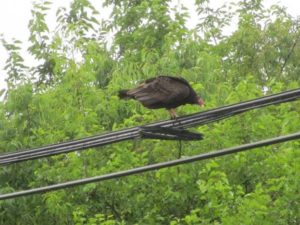
A turkey vulture, “Cathartes aura,” sits on a roadside utility line in Monroe after I spooked it when it was eating a dead ground hog, “Marmota monax.” Here, it is easily identified by its red head. Turkey vultures are commonly seen, soaring in a circle, their wings tipped into a V.
SUNRISE/SUNSET: For June 18, Sunday, to June 24, Saturday, the sun will rise between 5:25 and 5:30 a.m. and set about 8:30 p.m.
DATE TO KEEP IN MIND, JUNE 21: The longest daylight of the year is Wednesday, June 21, the summer solstice, when the sun rises at 5:28 a.m. and sets at 8:31 p.m. After June 21, daylight gets shorter.
DATE TO KEEP IN MIND, JUNE 24: St. John the Baptist Day. Sophie Majka, a neighbor who died March 8 at 92-years-old, had told me blueberries are ready to pick in the Pine Barrens around Helmetta on St. John’s Day, June 24. So, that is a target I look to.
WEATHER: The National Weather Service forecasting station for the area is at http://www.weather.gov/phi/.
SOURCES: As you can see, I have already mentioned various sources of information. Additionally, I enjoy listening to Mike McGrath’s “You Bet Your Garden” radio show on WHYY, 90.9 FM, out of Philadelphia – or on the Internet at http://whyy.org/cms/youbetyourgarden/. I also read Sally McCabe’s “In the Garden, It’s Time To…” column in the Philadelphia Inquirer newspaper, or on the Internet at philly.com.
MORE N’AWLINS FLAVOR IN HELMETTA: Why do I love traveling in the South? Maybe because I am a boy of the South – South Middlesex County. And my local roots go back to Helmetta, whose founder, for lack of a better term, George Washington Helme, was a Confederate military officer. Although a native of Kingston, Pennsylvania, Helme was a New Orleans resident during the Civil War. After the war, he came up to Helmetta, where his wife’s, Margaret Appleby Helme’s, family had a snuff mill operation – one that George would eventually take over. The George W. Helme Snuff Mill provided my family with work for approximately 75 years, from circa 1900 to 1976. The mill stopped manufacturing snuff in 1993 and, now, it is being converted into housing.
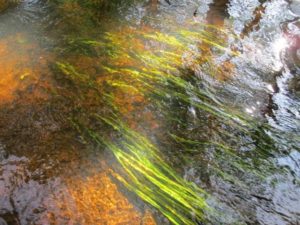
Looking into sunlit Manalapan Brook, here between Helmetta and Jamesburg.
Joe Sapia, 60, is a lifelong Monroe resident. He is a Pine Barrens naturalist and an organic vegetable-fruit gardener.
He gardens the same backyard plot as did his Italian-American father, Joe Sr., and his Polish-immigrant, maternal grandmother, Annie Poznanski Onda. Both are inspirations for his food gardening. Joe is active with the Rutgers University Master Gardeners/Middlesex County program. He draws inspiration on the Pine Barrens around Helmetta from his mother, Sophie Onda Sapia, who lived her whole life in these Pines, and his Grandma Annie. Joe’s work also is at @JosephSapia on Twitter.com, along with Facebook.com on the Jersey Midlands page.
Article and photos by Joe Sapia
Note: The yard references are to my house in the section of Monroe between Helmetta and Jamesburg in South Middlesex County. My yard is in a Pine Barrens outlier on the Inner Coastal Plain, the soil is loamy, and my neighborhood is on the boundary of Gardening Zones 6b (cooler) and 7a (warmer). Afield references are to the Pine Barrens around Helmetta, unless otherwise noted. Notes and photographs are for the period covered, unless otherwise noted.
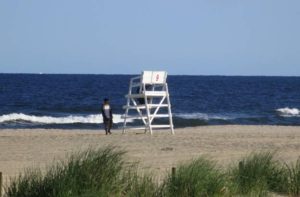
The Atlantic Ocean beach at Bradley Beach, Monmouth County
THE JERSEY SHORE SUMMER SEASON: The traditional Jersey Shore summer season arrives with Memorial Day Weekend, this weekend, and ends with Labor Day, this year September 4. (A tip: Jersey Shore people know September is a great month at the Shore – the crowds are gone and the weather and ocean are still warm.)
SPRINGTIME AT TONY’S MARKET: A favorite Jersey Midlands place of mine for decades has been Tony’s Farm and Garden Center in the Windsor section of Robbinsville, Mercer County. A nice selection of various products and owned and operated by the warm and helpful Ciaccio family. I regularly patronize three nursery-garden centers: Ferris Farms in East Brunswick, Krygier’s Nursery in South Brunswick, and Tony’s. At Tony’s, I buy houseplants and houseplant supplies. And I try to always shoot photographs at Tony’s.

Flowers at Tony’s Farm and Garden Center in the Windsor section of Robbinsville, Mercer County.
SIX-MILE RUN RESERVOIR SITE: On Wednesday, May 24, I hiked this area in Franklin, Somerset County, with the Outdoor Club of South Jersey. The area, about 3,000 acres and part of the Delaware and Raritan Canal State Park, had been planned for a reservoir, but that did not come to be. The terrain of red shale soil and traprock is part of the Piedmont geologic region. While pretty terrain – an area that I want to re-visit soon – much of it appears to be grown-over farmland, rather than a pure ecosystem.
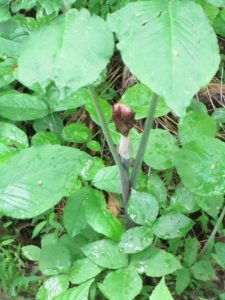
A Jack in the Pulpit flower, “Arisaema triphyllum,” in past-peak bloom at Six-Mile Run Reservoir.
MUSHROOMS: The wet weather may have produced mushrooms popping up in your yard or you simply may see mushrooms in the woods. BE CAREFUL! In my 60 years, I have learned only two mushrooms I feel comfortable picking – and I probably would still eat them with hesitancy out of fear, warranted or not. Remember the adage, “There are old mushroom pickers. There are bold mushroom pickers. There are NO bold AND old mushroom pickers.” It may be best to stay away from mushrooms in garden or afield.
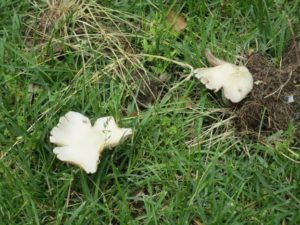
Mushrooms popping up post-rain in my backyard.
TURTLES AND MOUNTAIN LAUREL: Some Pine Barrens lore, “When the mountain laurel blooms, the snapping turtle lays its eggs.” Mountain laurel, “Kalmia latifolia,” is coming into bloom and, yes, snapping turtles, “Chelydra serpentina,” and other turtles are moving about. On Saturday, May 27, Priscilla “Peppy” Bath reported seeing a snapping turtle near her Mercer County home: “There was a huge turtle in the road. We stopped. Another car stopped and the turtle was not injured. But it was a big snapping turtle and the man was afraid to pick it up. Then, a young man on a bicycle came along and he picked it up and got it out of the road.” On the same day, I was driving on Route 206 in Burlington County and had to swerve to miss a box turtle, “Terrapene carolina carolina,” crossing 206. The car behind my Jeep hit it, but it appeared to nick it safely, knocking it to the side of the road. So, a heads-up while driving. If you move a turtle, move it in the direction it was traveling. If it is a snapper, I would use a shovel, not my hands. And, if using one’s hands, do not pick it up by its tail, which could injure it.
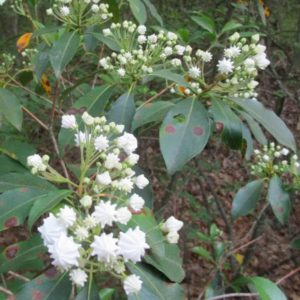
Mountain laurel about ready to go into full bloom at Jamesburg Park in the Pine Barrens around Helmetta.
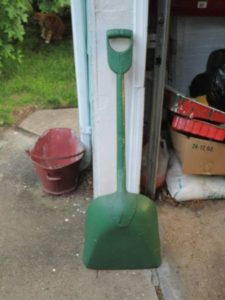
I keep this type of grain shovel in my Jeep to move snapping turtles off roads.
TREE MULCHING: I see so many examples of “volcano” mulching, or the wrong way to mulch a tree. Creating the volcano-look, or the pileup of mulch against a tree could cause too much wetness around the bark or make the tree susceptible to insect infestation or disease. Instead, use the “doughnut” method of placing the “doughnut hole” outside of the tree and its exposed roots, so the mulch is not touching bark. Outside of the hole, the mulch should be about only 2 or 3 inches in depth, so as not to overwet the tree. The outer rim of the “doughnut” should go to the end of the root ball or the tree canopy/drip line. If a tree is established, there is no need for mulching.
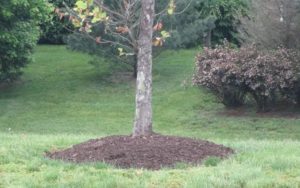
The mulch “volcano,” or the wrong way to mulch a tree, in South Brunswick, Middlesex County.
BLACKWELLS MILLS GARDENS: The gardens looked beautiful, here — in Franklin, Somerset County — which is part of Delaware and Raritan Canal State Park.
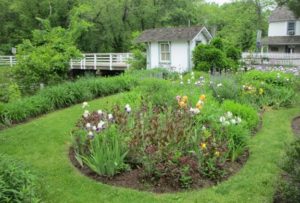
The garden at the circa 1830 bridge tender station at Blackwells Mills.
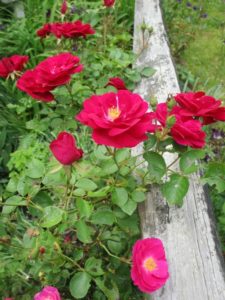
Flowers at Blackwells Mills.
MOON: The crescent moon waxes toward the June 9 Full Strawberry Moon.
GARDEN AND AFIELD: I already had some lower broom sedge, “Andropogon virginicus variety abbreviates,” gathered, here, in the Pine Barrens around Helmetta on display on my kitchen table. So, with my “Knock Out” Roses blooming, I just added some of those to the vase.
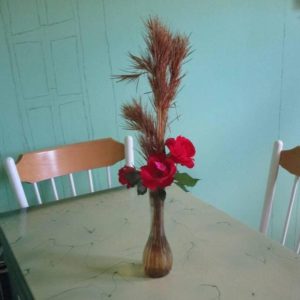
“Knock Out” Roses and lower broom sedge on my kitchen table.
SUNRISE/SUNSET: For the week of May 28, Sunday, to June 3, Saturday, the sun will rise about 5:30 a.m. and set about 8:20 p.m.
WEATHER: The National Weather Service forecasting station for the area is at http://www.weather.gov/phi/.
MY GARDEN: I am simply practicing the three Ws: Water, Weed, and Wait – waiting for lettuce, carrot, pea, sweet corn, tomato, mushmelon, cucumber, and zinnia to grow and be picked.
Joe Sapia, 60, is a lifelong Monroe resident. He is a Pine Barrens naturalist and an organic vegetable-fruit gardener.
He gardens the same backyard plot as did his Italian-American father, Joe Sr., and his Polish-immigrant, maternal grandmother, Annie Poznanski Onda. Both are inspirations for his food gardening. Joe is active with the Rutgers University Master Gardeners/Middlesex County program. He draws inspiration on the Pine Barrens around Helmetta from his mother, Sophie Onda Sapia, who lived her whole life in these Pines, and his Grandma Annie. Joe’s work also is at @JosephSapia on Twitter.com, along with Facebook.com on the Jersey Midlands page.
by Joseph Sapia
Gardening: In Helmetta, Monroe, and Jamesburg
2016, August 7, Sunday, to August 13, Saturday
The gardening and yard references are to my house in the section of Monroe between Helmetta and Jamesburg in South Middlesex County. My yard is in a Pine Barrens outlier on the Inner Coastal Plain, the soil is loamy, and my neighborhood is on the boundary of Gardening Zones 6b and 7a.
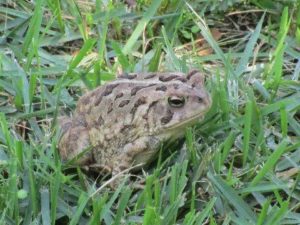
Fowler’s Toad
HARVESTING: Cucumbers. Picked a cantaloupe, but I should have waited. So, holding off on picking more cantaloupes.
TO HARVEST OR NOT TO HARVEST: My tomatoes are not moving – they are not growing and ripening, plants are dying. I think the wildlife has been getting to them….
THE LAWN: Because of work and the weather not cooperating on my days off (that is, either raining or threatening thunder storms with lightning), I got way behind on cutting the grass. So,…
CUTTING THE GRASS IN THE HEAT: I jumped on a sunny, day-off opportunity to cut the lawn – in 95 degrees with a heat index of 114 degrees. I wet my straw hat, stayed hydrated by drinking plenty of water, and took breaks. It was a grind for this old (59) boy. Three wet T-shirts and one fear-of-lightning break later, I finished the backyard.
CUTTING DOWN THE GARDEN: I mowed over the area where the lettuce had been planted – and, now, considering planting a late crop of lettuce. I also mowed down for the most part the done-producing corn stalks.
WILDLIFE IN THE YARD: The raccoons continue to topple the bird-feeder if I do not get it in the garage early enough at night. And I came across a Fowler’s toad — easily identifiable by the several warts in the splotches –while cutting the lawn. And, yes, the toad urinated when I caught him. I let him go in one of the high-grass wildlife patches I keep in the yard. (Photo of the Fowler’s toad.)
ROSE THORN IN MY FOOT: Despite wearing sneakers, I got a rose thorn in the big-toe area of my right foot. Pulled that sucker out fully. Not like the thorn or whatever that I have/had stuck in the ball of my left foot for about three weeks. Just keeping an eye on it, making sure it is not infected, waiting for it to work itself out.
MOSQUITOES: NJ has had at least three cases of West Nile virus in humans – one in Camden County, according to the state; two in Monmouth County (Atlantic Highlands and the Spring Lake area), according to the county. I checked a barrel I keep with a combination of rain, gray water, and de-humidifier water and found mosquito larvae in it. So, I emptied some of it and put a top on the barrel of the remainder. Interestingly, I cannot recall one mosquito bite this season.
— Joseph Sapia
2016, August 13, Saturday,
Joe Sapia, 59, has lived his whole life in Monroe. He is, among other things, a Pine Barrens naturalist and a vegetable gardener. He gardens the same backyard plot as did his Italian-American father, Joe Sr., and his Polish maternal grandmother, Annie Poznanski Onda. Both are inspirations for his vegetable gardening. And he draws inspiration on the local Pine Barrens from his mother, Sophie Onda Sapia, who lived her whole life in the local Pines, and his grandmother.
Photos and Writing by Joseph Sapia
The gardening and yard references are to my house in the section of Monroe between Helmetta and Jamesburg in South Middlesex County. My yard is in a Pine Barrens outlier on the Inner Coastal Plain, the soil is loamy, on the boundary of Gardening Zones 6b and 7a.
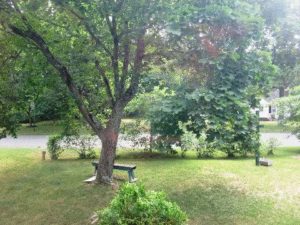
Front yard
EARLY MORNING HOURS IN THE GARDEN: On Wednesday, I got up around 5:20 a.m. for an early day at work and had the garden half-watered by 6 a.m. I watched the sky change color, listened to a crow, and watched a great blue heron fly by. Peace!
HARVESTING LETTUCE: I dug out 2 heads of lettuce and brought them to work for distribution. Worried the lettuce would start bolting in the heat wave, I was looking to use it up. It turns out there was no need to worry. The lettuce is still producing well, despite the heat.
LAST YEAR’S SUNFLOWERS: I had forgot I have last year’s sunflower crop hanging from the ceiling and drying in the garage. Well, I remembered and began spreading the seeds for the birds, squirrels, and any other wildlife that eats them.
BEARS ON THE MOVE: Various roaming black bear reports have come in over the last week or so: in South Brunswick and Milltown, for example. Stay clear and all should be OK.
FLOWERS IN THE VEGETABLE GARDEN: Cantaloupes, peas, and cucumbers are flowering, the sweet corn is in tassel, and a white flower is blooming. As for white flower, I am unsure if it is growing on its own, part of the pollinator seeds I threw down, or something else.
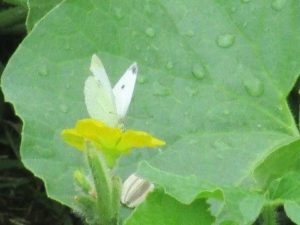
Cabbage White on Cantaloupe
“KNOCK OUT” ROSES: The “Knock Outs” seem to be doing something different this year — peaking, but retaining blooms, rather than losing all blooms until the next peak.

Knock Out Rose
AROUND THE YARD: Stinkhorn mushrooms are popping up.
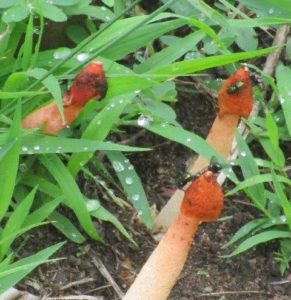
Flies on Stinkhorn Mushrooms
YARDWORK: Saturday’s thunderstorm forecast kept me from my planned trimming of the shrubs and hoeing the vegetable garden. The shrubs can wait, but I really need to attack the garden weeds on Sunday.
QUOTE OF THE WEEK: Friend Jimmy Krygier, a 3rd generation nurseryman of the 100-year Krygier’s Nursery on Cranbury Road just outside Helmetta, noted the perkiness of the vegetation as we were driving a backroad after the recent rains and he said something to the effect of, “The vegetation is smiling because of the rain. Even the weeds.”
DOWN THE SHORE: The clinging jellyfish, “Gonionemus vertens,” an invasive species indigenous to the Asian Pacific Ocean, has been found in the Shrewsbury River and Manasquan River recently. Their stings are very hurtful and could require hospitalization. They are not expected in Raritan Bay or in the Atlantic Ocean.
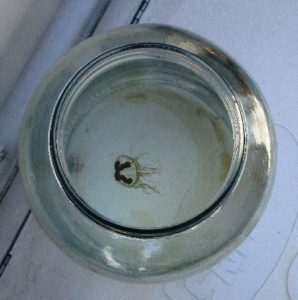
Clinging jellyfish from the Shrewsbury River at Monmouth Beach
SOMETHING TO WATCH FOR: In the local Pine Barrens, watch for the beginning of the “fall” foliage colors from around July 15 to July 30.
Joe Sapia, 59, has lived his whole life in Monroe. He is, among other things, a Pine Barrens naturalist and a vegetable gardener. He gardens the same backyard plot as did his Italian-American father, Joe Sr., and his Polish maternal grandmother, Annie Poznanski Onda. Both are inspirations for his vegetable gardening. And he draws inspiration on the local Pine Barrens from his mother, Sophie Onda Sapia, who lived her whole life in the local Pines, and his grandmother.
Photos and Writing by Joseph Sapia
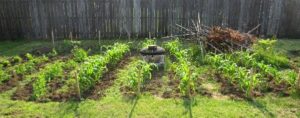
GARDEN AND AFIELD
2016, June 19, Sunday, to 2016, June 25, Saturday
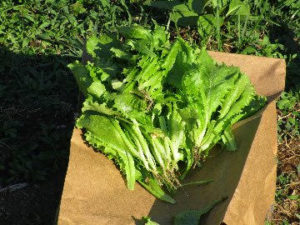
Lettuce
HARVESTING FROM THE GARDEN: I began picking lettuce, harvesting it leaf by leaf, rather than by the head, so the plant keeps producing. (In my haste, I pulled out too much leaf. So, next time, will clip them, saving the plant.) Then, I either munch on the leaf right there in the garden or take it inside for a sandwich.
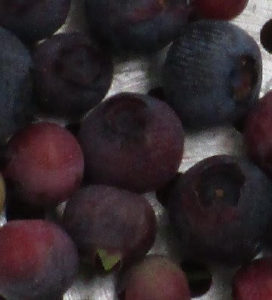
Wild blueberries
HARVESTING FROM THE LOCAL PINE BARRENS: Blueberries are ripening. I picked some the other day and mixed them into a cup of yogurt.
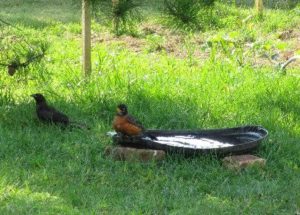
Bird bath
BIRD BATH: I keep a bird bath filled with water at ground level. Birds not only “bathe” in it, but birds and other animals drink from it.
WILDLIFE IN THE YARD: The raccoons are still taking advantage of the sunflower kernels in the bird-feeder. And, one evening, I saw a huge skunk passing by.
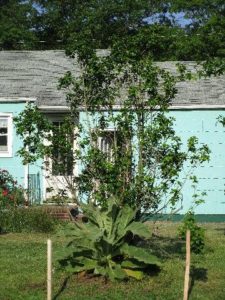
Mullein in front of the American holly
WEEDS IN MY YARD: As I have mentioned, I leave many weeds growing to see what they develop into. Well, I have a huge mullein taking over my American holly in my backyard. In the front yard, I have pokeweed growing.
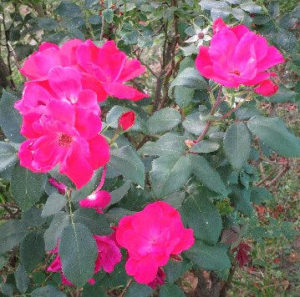
“Knock Out” roses
“KNOCK OUT” ROSES: Surprisingly, the first bloom of “Knock Out” roses continues.

Fungi in the backyard
FUNGUS, IN YARD AND WOODS: Fungi growing in my backyard and some in the local Pine Barrens.
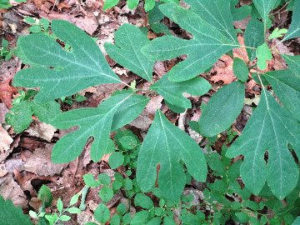
Sassafras with its three styles of leaves
SASSAFRAS IN THE LOCAL PINE BARRENS: Sassafras trees can have three leaf patterns on the same tree: a two-prong mitt, three-prong, and oval. I found an aberration this week, one with five prongs.
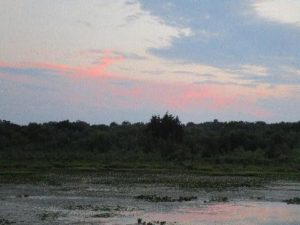
Helmetta Pond at sunset
Joe Sapia has been a professional journalist since the 1970s. He also is a writing teacher, folk artist, vegetable gardener, Pine Barrens woodsman, Helmetta area historian, and Jeep driver, along with being Marquette University Jesuit-educated..
Born in 1956, Joe is a lifelong resident of Central Jersey, where his family — through his maternal side, the old Polish and Slovak workers of the George W. Helme Snuff Mill in Helmetta — has lived since about 1900. He is a voice of the land and Old Jersey ways.
































